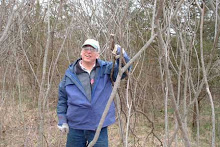Prof. Mark Hunter gave a fascinating presentation on "The Natural and Un-Natural History of Milkweeds: Insects, Toxins and Other Stories" at the combined meeting of the Michigan Botanical Club - Huron Valley Chapter and Wild Ones - Ann Arbor Chapter on Monday, April 21, at
Matthei Botanical Gardens, 7:45 PM.
Many insects use milkweed blossoms. Native bees and wasps, butterflies and moths all feast on the nutritious nectar.

You may be aware that Monarch butterflies depend on milkweed as a larval host. That is, the adults lay eggs on milkweed leaves, and when the eggs hatch, caterpillars eat the leaves.
There's a nice overview on the
Monarch Watch site.
Monarchs have evolved a way to deal with the specialized chemicals that milkweeds produce, and may use it to reduce the effects of a parasite (Ophryocystis elektroscirrha).
Many other species have evolved tolerance, including a specialized food chain of aphids, crab spiders, and pampilid wasps. Here's a milkweed beetle.





